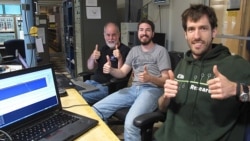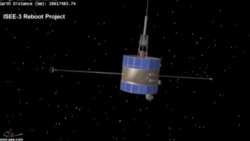For the first time, NASA, the U.S. space agency, has handed over the reins of one its spacecraft to a group of ordinary people. The International Sun Earth Explorer 3 was launched in 1978 to study space weather and collect data on the streams of particles flowing from the sun. Those particles, also known as solar wind, can damage satellites, interrupt radio signals and knock out electric systems that power our homes.
ISEE-3 had a great run. In the early-1980s, it was the first spacecraft to fly through the tail of a comet, and a few years later, through a second one - the famed Haley's comet. Retired in 1997, NASA set the satellite to fly by the moon in August, 2014.
1970s-era probe
The 1970s-era probe was largely forgotten until its return date approached. In early April, just four months before ISEE-3’s expected flyby, NASA engineer Keith Cowing organized a team to try to take command of the craft and set it on a path nearer to earth. With the go-ahead from NASA and funds gathered from a crowdsourcing website, the Reboot Project was born.
Working out of a defunct McDonalds restaurant at NASA Ames Research Center in Mountain View, California, Cowing never doubted the project would succeed. Every few years a radio telescope would make contact. “We knew it was alive,” Cowing said. “If we could hear it, that meant that it had electricity, which meant its solar cells were working and it had two transmitters. That is two of the most important things. You have power and you could talk to the spacecraft.”
Establishing Contact and Command
But ISEE-3 had no computer on board. So the Reboot Project set out to engineer a 21st century fix, says Cowing.
“We looked through storage units to get documents that people had saved for 30 years," he said. "We found the commands and we found people who could write software to recreate the hardware that had been thrown out. And, it was a mystery in reverse, going back in time and resurrecting data, we call it techno-archeology.”
The team built a new transmitter and installed it on the world’s largest radio telescope, at the Arecibo Observatory in Puerto Rico. They made contact on May 29.
“And it answered back. That was an accomplishment,” said Cowing. “And everything worked on the spacecraft, except the propulsion system that would have put the craft into a new orbit. At first we actually got the engines to fire to spin the spacecraft up a little bit, which everybody thought was impossible, but eventually we reached a point that there was a problem with the fuel system where there was not enough gas to build up enough pressure to fire the engine."
Sending back science again
ISEE-3 flew by the moon about 13,000 to 14,000 kilometers away on August 10.
“We did not really change its course all that much," Cowing admitted, but added, "The difference is it is now sending back science to us.”
Solar cells kept the satellite working, an amazing feat after nearly half a century. ISEE-3 proved that its simple design worked, Cowing says. The data is free and available online to anyone who wants to take a scientific journey with the rebooted probe.
The satellite will not be this close to Earth again until 2029.
Reboot project co-leader Keith Cowing describes the Reboot Mission, (credit: ICEE-3 Reboot Project):













